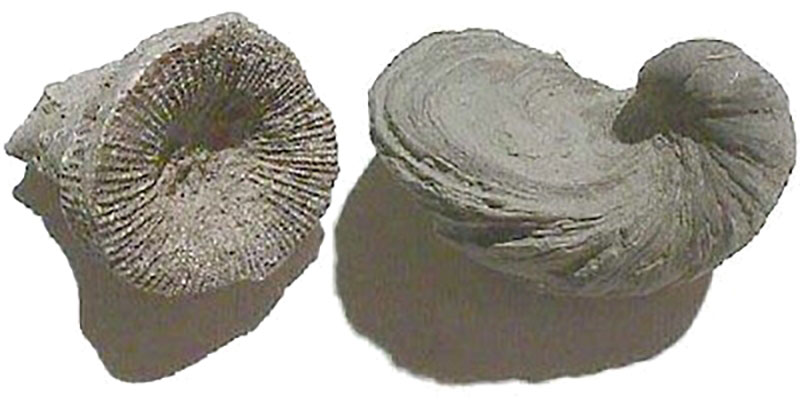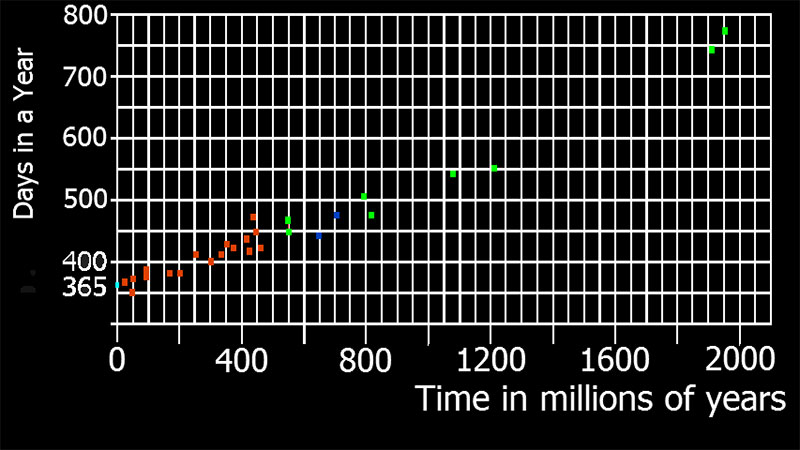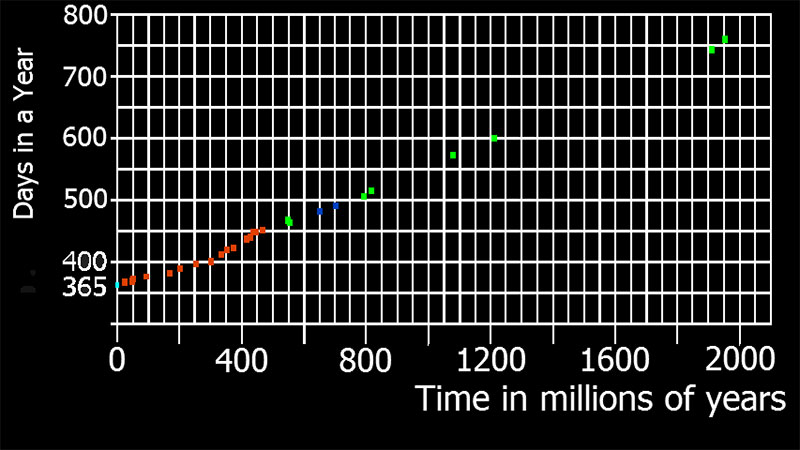This third part on lunar recession deals with paleontological data claimed as evidence of four lunar recession over deep time. This is not correct data, about the fossil evidence that is interpreted within the old earth model as producing such data. While this is not a problem from the perspective of Biblical creation you know because Calculations are not valid from a creationist perspective, and it is too scattered to represent real data. However, it provides a set of data to compare old earth models for lunar recession that they must obey.
Paleontological Data
Old Earth proponents often point to paleontological data as evidence that the previous backward projections are wrong. The claim will often include a few examples that are often dated as millions of years apart. However, this claim does not consider all of the facts about this data including alternative interpretations that do not have anything to do with lunar recession and the length of an Earth day. This paleontological data comes in the form of fossil bivalves and coral, fossil "stromatolites", and fossil "tidal rhythmites." Bivalves and coral are animals that tend to live about a year and show daily growth rings on their hard exteriors. Stromatolites are produced by the activity of cyanobacteria. Tidal Rhythmites are produced by tidal action.
Stromatolites

Stromatolites are produced by the activity of cyanobacteria and living colonies produce 365 layers in a year. Fossil "colonies” have been found with 450-800 layers in apparent agreement with the slowing of the Earth rotation through the geologic ages. The main problem is that fossil stromatolites may not have formed from cyanobacteria. Some contain no evidence of the cyanobacteria and carbonate precipitation can result in some very stromatolite like structures, rendering the number of layers meaningless. However, even if they are legitimate fossil stromatolites it could just mean that the colonies lived longer than a year in the past.
Tidal Rhythmites

Tidal Rhythmites are produced by tidal action, so-called fossil tidal rhythmites are assumed to indicate the moon's position and the number of days in a month or year in the past. Now getting this data out of rock patterns is not a simple process. It is based on the fact that there are two high tides in a day and they change over a month from different positions of the moon. Figuring out the number of days in a month or year in the past requires comparing patterns in the rocks with patterns expected to be produced by the moon.
The main problem with this is that it requires making assumptions about where the moon was at the time, resulting in a degree of circular reasoning. In addition, there are factors that distort the tidal rhythmites producing erroneous patterns. There is also an additional problem since the types of same patterns occur in varves. This leads to the question of whether or not these are rhythmites or varves? It turns out the even experts have a hard time telling them apart in the geologic record. If they are varves then the patterns are meaningless for determining past lunar positions or the number of days in a year.
Bivalves and Coral

Coral and bivalves normally produce one growth ring per day, normally it is 365. Due to the slowing of Earth rotation coral would have had more rings in the past on an old Earth. Fossil coral and bivalves have been found with 357-450 growth rings. The extra growth rings are assumed to indicated more days per year. However, they could mean that these corals and bivalves lived for more than a year. Furthermore, in some cases what are being examined are monthly growth rings with the number of day in a year is calculated based on an assumption of more than twelve shorter lunar months. In those cases, it is assumed that both days and lunar months were shorter making it circular reasoning to use it as evidence for the same.

Made from data from
The Present is Key to Past, 365 Topics in Historical Geology
by Hugh Rance (revised July 2012)
Stromatolites, (green) fossil tidal rhythmites, (blue) and fossil bivalves (red) and coral (orange) all have indicators interpreted as showing more days in a year in the past. However, when one looks closely at this data, the claim is shown not to be so certain. The first clue is the fact that the degree of scattering in the data is not what would be expected if it were really the result of lunar rescission. A major clue that this is not real data on this line of the Earth’s rotation what are the fossil bivalves there were shows only 357 days which would only make sense if it was actually from the future given the fact that a real year is 365 days.

It should produce a clear curve like as seen above but it does not. Now scattering often occurs in data, but in this case, there is no reason for this degree of scattering. If there were a clearer line with a little scattering the scattering could be early deaths. However, the actual degree of scattering does not show this.

From a creation science perspective, the scattering of the fossil bivalves and coral (orange) could easily be a result of hydrological sorting during the Genesis Flood since those with more growth rings would be larger and thereby end up buried lower, and the scattering results from hydrological sorting being an imperfect t process. The Stromatolite data shows four pairs of data points. The "older" two pairs could be pre-Flood and may even have been formed during the creation week. The other two pairs seem to be early Flood deposits. The relationship within each pair shows no trend. However, there is a trend among the pairs, and in particular among the three older pairs. This could simply represent a change in precipitation patterns.
The basic assumption of this data that makes it meaningful to lunar recession is the dates. If the dates are wrong and these fossils and features were a result of the Genesis Flood or a recent creation, then it would not be expected to fit a lunar recession model consistent with a 4.5-billion-year-old Earth. From an old Earth perspective, this data represents real data on the slowing of the Earth's rotation. Thus, any viable Old Earth model needs to fit with this data. If the old Earth model does not fit this paleontological data, it is a failed model.
In part four we will pick up with examining various models to try to save an old Earth.
Help support these articles.
https://tinyurl.com/GSM-give yeah
References
http://gscim.xyz/Articles/Advanced/Lunar_recession_and_the_Age_of_the_Earth/
http://gscim.xyz/Articles/Intermediate/Lunar_recession_and_the_Age_of_the_Earth/












